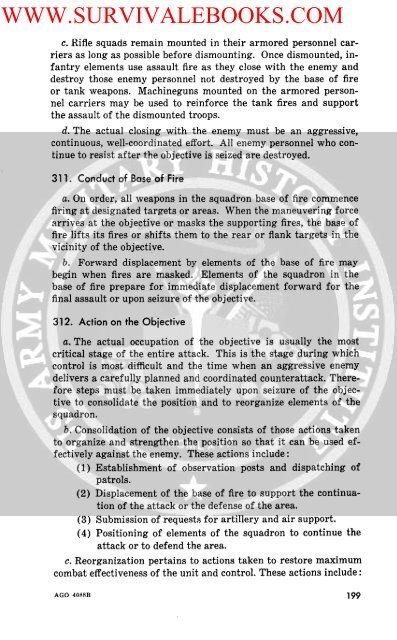FM 17-35 ( Armored Cavalry Platoon, Troop and Squadron ) 1960
FM 17-35 ( Armored Cavalry Platoon, Troop and Squadron ) 1960
FM 17-35 ( Armored Cavalry Platoon, Troop and Squadron ) 1960
You also want an ePaper? Increase the reach of your titles
YUMPU automatically turns print PDFs into web optimized ePapers that Google loves.
WWW.SURVIVALEBOOKS.COM<br />
c. Rifle squads remain mounted in their armored personnel carriers<br />
as long as possible before dismounting. Once dismounted, infantry<br />
elements use assault fire as they close with the enemy <strong>and</strong><br />
destroy those enemy personnel not destroyed by the base of fire<br />
or tank weapons. Machineguns mounted on the armored personnel<br />
carriers may be used to reinforce the tank fires <strong>and</strong> support<br />
the assault of the dismounted troops.<br />
d. The actual closing with the enemy must be an aggressive,<br />
continuous, well-coordinated effort. All enemy personnel who continue<br />
to resist after the objective is seized are destroyed.<br />
311. Conduct of Base of Fire<br />
a. On order, all weapons in the squadron base of fire commence<br />
firing at designated targets or areas. When the maneuvering force<br />
arrives at the objective or masks the supporting fires, the base of<br />
fire lifts its fires or shifts them to the rear or flank targets in the<br />
vicinity of the objective.<br />
b. Forward displacement by elements of the base of fire may<br />
begin when fires are masked. Elements of the squadron in the<br />
base of fire prepare for immediate displacement forward for the<br />
final assault or upon seizure of the objective.<br />
312. Action on the Objective<br />
a. The actual occupation of the objective is usually the most<br />
critical stage of the entire attack. This is the stage during which<br />
control is most difficult <strong>and</strong> the time when an aggressive enemy<br />
delivers a carefully planned <strong>and</strong> coordinated counterattack. Therefore<br />
steps must be taken immediately upon seizure of the objective<br />
to consolidate the position <strong>and</strong> to reorganize elements of the<br />
squadron.<br />
b. Consolidation of the objective consists of those actions taken<br />
to organize <strong>and</strong> strengthen the position so that it can be used effectively<br />
against the enemy. These actions include:<br />
(1) Establishment of observation posts <strong>and</strong> dispatching of<br />
patrols.<br />
(2) Displacement of the base of fire to support the continuation<br />
of the attack or the defense of the area.<br />
(3) Submission of requests for artillery <strong>and</strong> air support.<br />
(4) Positioning of elements of the squadron to continue the<br />
attack or to defend the area.<br />
c. Reorganization pertains to actions taken to restore maximum<br />
combat effectiveness of the unit <strong>and</strong> control. These actions include:<br />
AGO 4088B 199

















